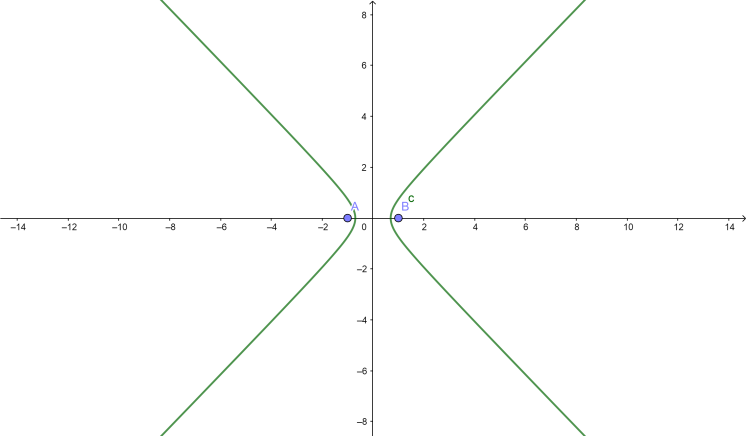
How do I determine whether a hyperbola opens horizontally or vertically?
Answer
540k+ views
Hint: First we know it is a horizontal or vertical hyperbola.
If it is a horizontal hyperbola since the $x$ term is positive.
\[\dfrac{{{{(x - h)}^2}}}{{{a^2}}} - \dfrac{{{{(y - k)}^2}}}{{{b^2}}} = 1\]
That means the curves open left and right.
If it is a vertical hyperbola since the $y$ term is positive.
$\dfrac{{{{(y - k)}^2}}}{{{a^2}}} - \dfrac{{{{(x - h)}^2}}}{{{b^2}}} = 1$
That means the curves open up and down.
Complete step by step answer:The graph of a hyperbola creates two smooth curves as pictured here:

There are two patterns for hyperbolas:
Horizontal:
\[\dfrac{{{{(x - h)}^2}}}{{{a^2}}} - \dfrac{{{{(y - k)}^2}}}{{{b^2}}} = 1\]
Vertical:
$\dfrac{{{{(y - k)}^2}}}{{{a^2}}} - \dfrac{{{{(x - h)}^2}}}{{{b^2}}} = 1$
We can determine the following:
If it is vertical or horizontal:
If the $x$ term is positive, the parabola is horizontal (the curves open left and right). The equation is,
\[\dfrac{{{{(x - h)}^2}}}{{{a^2}}} - \dfrac{{{{(y - k)}^2}}}{{{b^2}}} = 1\]
The horizontal parabola graph is

If the $y$ term is positive, the parabola is vertical (the curves open up and down). The equation is
$\dfrac{{{{(y - k)}^2}}}{{{a^2}}} - \dfrac{{{{(x - h)}^2}}}{{{b^2}}} = 1$
The vertical parabola graph is

The center point as with all conic sections, the center points $(h,k)$ . Notice that the $h$ is always with the $x$ and the $k$ is always with the $y$ . There is also a negative in front of each, so you must take the opposite.
The $a$ and $b$ values will be needed to graph the parabola. Notice that $a$ is always under the positive term and $b$ is always under the negative.
Note:
Notice that $(h,k)$ is the center of the entire hyperbola but does not fall on the hyperbola itself. Each hyperbola has a vertex and two asymptotes guide how wide or how narrow the curve.
If $x$ is on the front, the hyperbola opens horizontally.
If $y$ is on the front, the hyperbola opens vertically.
If it is a horizontal hyperbola since the $x$ term is positive.
\[\dfrac{{{{(x - h)}^2}}}{{{a^2}}} - \dfrac{{{{(y - k)}^2}}}{{{b^2}}} = 1\]
That means the curves open left and right.
If it is a vertical hyperbola since the $y$ term is positive.
$\dfrac{{{{(y - k)}^2}}}{{{a^2}}} - \dfrac{{{{(x - h)}^2}}}{{{b^2}}} = 1$
That means the curves open up and down.
Complete step by step answer:The graph of a hyperbola creates two smooth curves as pictured here:

There are two patterns for hyperbolas:
Horizontal:
\[\dfrac{{{{(x - h)}^2}}}{{{a^2}}} - \dfrac{{{{(y - k)}^2}}}{{{b^2}}} = 1\]
Vertical:
$\dfrac{{{{(y - k)}^2}}}{{{a^2}}} - \dfrac{{{{(x - h)}^2}}}{{{b^2}}} = 1$
We can determine the following:
If it is vertical or horizontal:
If the $x$ term is positive, the parabola is horizontal (the curves open left and right). The equation is,
\[\dfrac{{{{(x - h)}^2}}}{{{a^2}}} - \dfrac{{{{(y - k)}^2}}}{{{b^2}}} = 1\]
The horizontal parabola graph is

If the $y$ term is positive, the parabola is vertical (the curves open up and down). The equation is
$\dfrac{{{{(y - k)}^2}}}{{{a^2}}} - \dfrac{{{{(x - h)}^2}}}{{{b^2}}} = 1$
The vertical parabola graph is

The center point as with all conic sections, the center points $(h,k)$ . Notice that the $h$ is always with the $x$ and the $k$ is always with the $y$ . There is also a negative in front of each, so you must take the opposite.
The $a$ and $b$ values will be needed to graph the parabola. Notice that $a$ is always under the positive term and $b$ is always under the negative.
Note:
Notice that $(h,k)$ is the center of the entire hyperbola but does not fall on the hyperbola itself. Each hyperbola has a vertex and two asymptotes guide how wide or how narrow the curve.
If $x$ is on the front, the hyperbola opens horizontally.
If $y$ is on the front, the hyperbola opens vertically.
Recently Updated Pages
Master Class 12 Business Studies: Engaging Questions & Answers for Success

Master Class 12 Economics: Engaging Questions & Answers for Success

Master Class 12 English: Engaging Questions & Answers for Success

Master Class 12 Maths: Engaging Questions & Answers for Success

Master Class 12 Social Science: Engaging Questions & Answers for Success

Master Class 12 Chemistry: Engaging Questions & Answers for Success

Trending doubts
What is meant by exothermic and endothermic reactions class 11 chemistry CBSE

Which animal has three hearts class 11 biology CBSE

10 examples of friction in our daily life

One Metric ton is equal to kg A 10000 B 1000 C 100 class 11 physics CBSE

1 Quintal is equal to a 110 kg b 10 kg c 100kg d 1000 class 11 physics CBSE

Difference Between Prokaryotic Cells and Eukaryotic Cells




